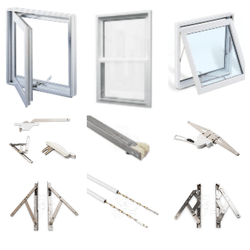Finding the right window hardware replacement parts | DIY Window Repair
Diagnosing, sourcing, and replacing your window hardware doesn't have to be complicated. We'll try to break it down in simple, easy to follow steps to help you get up and on your way to restoring your windows back into working condition.
To start, understanding what type of windows you need replacement hardware for is important in helping vendors and even window maintenance repair people understand your particular situation.
In most cases, you will have one of the three following types of windows:

|

|
|
| Casement Window | Awning Window | Double Hung Window |
Don't see your particular type of window above or need a bit of extra help?
Give us a call or send us an email.
Now that we have identified which type of window you are dealing with. Let's familiarize ourselves with a few terms that will come in handy when it's time to diagnose or buy replacement parts.
Sash: The window sash in most modern types of window configurations refers to the part of the window that holds the glass, and is fitted into the window frame. An easy way to differentiate between the window frame and the window sash is to identify the operational section of your window, for example - the section that opens and closes.
Sash Locks: As the name infers, sash locks are meant to secure your sash to the window frame. In properly constructed and installed windows the sash locks have very little to do with the sealing of the window and serve primarily as a security measure.
Window Operators: Commonly referred to as cranks, mechanisms, or winders - window operators facilitate the opening and closing of your window, or more specifically the sash. Window operators traditionally deal with both casement and awning type windows. With a variety of types to choose from, we'll explore a few additional steps below to help you easily identify and source the window operators you need.
Hinges: Window hinges come in a variety of sizes and strengths and are found on both casement and awning style windows. Hinges work in conjunction with the operator to limit the angle of opening and facilitate a smooth transition between open and closed. A vital role of your window hinges is ensuring the operating sash is kept both square and plumb.
Window Balances: Often found in double hung window configurations, window balances, also known as sash balances are responsible for aiding the smooth transition between open and closed. In both residential and commercial settings, spring based sash balances are quite common. Spring based sash balances are typically affixed to the channel of the window frame and move in conjunction with the sash to ensure tension secures or helps facilitate the smooth operation of the sash.
Now, let's take a look at some basic strategies to diagnose your operational window problems and hopefully save you a few bucks along the way.
Structural Integrity and Hinges:
Want to maintain your energy rating, deal with less maintenance issues, and enjoy fully operational windows? Ensure your windows and their respective sashes are plumb, level, square, and true.
So what is plumb and why is it important for my windows?
When we talk about plumb, we are not referring to the fruit! In this context, being plumb refers to the vertical orientation of both the window frame and the sash. To help you understand, think of a wooden stake in perfectly flat ground. If the stake forms a 90 degree angle with the surface of the ground, we would say that it is in fact plumb. If the stake were to lean to either side, consequently, we would say it is out of plumb.
Plumb windows helps avoid optional binding, ensuring your windows open and close smoothly. For the sake of window hardware replacement parts, an important diagnostic step is ensuring the operating sash is in fact plumb with the window frame. Similar to shower glass doors, yard gates, or common kitchen cupboards, the "plumbness" of your operating sash is often dictated by the condition and functionality of your hinges. So what may be causing your hinges to fail? Elemental degradation can cause your hinges to fail, particularly if you live in coastal regions that degrade the integrity of your composite hinge material. Another more common cause of window hinge failure can often be attributed to incorrect installation or inadequate weight ratings in relation to the weight of your particular sash. For example, a chain link fence gate is generally lighter than a wooden gate, substituting a wooden gate in place of a chain link fence without ensuring the hinges can support that additional weight will undoubtedly lead to hinge failure over time.
Leveled windows play a vital role in maximizing energy efficiency and ensuring your windows function the way they were designed to. Have you ever stood beside a window and felt a cold draft? While not always the case, it could be caused by incorrect leveling of the window. Level window frames help ensure sashes seat properly reducing jamb bindings and forming a thorough seal between the weather stripping.
Square windows and sashes refer to the corners of both. In fact, for a window or a sash to be square - they must be both plumb and level.
Lastly, and often overlooked is the notion of true.
For a window to be true, it must be square on both the level and plumb axis. This type of issue is more easily visualized with awning style windows and can often be attributed to failing hinges or window operators. A correctly installed window that is true will be perfectly square, plumb, and level on BOTH sides.
To learn more about the differences between plumb, square, level, and true and how it relates to windows or doors, check out this article.
Window Operators and Binding:
A majority of window operator problems can be attributed to structural integrity issues and hinge failure as discussed above. Consequently, the additional binding of the sash on the frame, or inadequate closing can often lead to over-use on the operator, stripped gears, and stripped handle splines. While there are a variety of finishes, mounting options, styles, and lengths of window operators available, finding the right one of your job can be easy. At Ontario Glazing Supplies we have tried to systematically arrange our selection of window hardware to help make this process easier.
7 simple steps to identify and purchase your replacement window operator
Step 1. Identify the type of window for which you are replacing the operator.
For example:
The following is the basic flow for identifying and ordering your replacement casement window operator:
Step 2. Select the number of arms you see or feel on your current operator.
For example:
Step 3. With the number of arms identified, determine whether it is a continuous arm (solid) or a hinged arm (dyad).
For example:
Step 4. Select the manufacturer, often indicated on the arm of your current operator.
For example:
Unsure about the manufacturer? No problem! Either browse the currently displaying selection of operators or send us a picture and we will figure it out for you.
Step 5. Identify the window operator style based on the previously selected criteria.
For example:
Step 6. Measure the length of the operator arm you need.
In most cases, this is performed by measuring the end of the operator to the center of the gear.
Step 7. Select the product, and choose the finish that best suits your needs.
At Ontario Glazing Supplies, we sell window hardware replacement parts but we also rent or own homes too. Having more than 50 years of combined knowledge and application in the window industry, we value the opportunity to help people accomplish their DIY window repair goals. If you have any questions, please feel free to give us a call, send us an email, or stop by in person.


 Canadian Dollars
Canadian Dollars
 US Dollar
US Dollar
 Mexican Peso
Mexican Peso
 Euro
Euro
 British Pound
British Pound
 Australian Dollar
Australian Dollar

